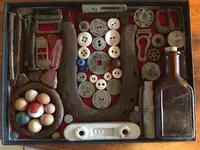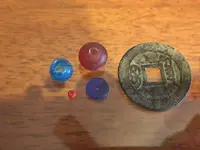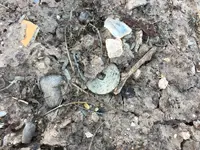Old Pueblo
Bronze Member
Hello again, just wanted to show you some more of my recent finds from here in southern Arizona, and how I like to display them in a rikers case. To start, it was kind of an unusual day in that I was hunting with my dear old mother, and not really looking for these kind of things, but managed to find #2 on my bucket list of finds. Anyway, it was around the time of her recent birthday, so we took a drive out and I took her to one of my "hunting spots" to show her this old farmhouse that is rotting away.
I had only walked around this place one other time and happened to spot a few glass and clay marbles, some of the buttons you see there, a bead or two, and a 1940s wheat penny on the ground, but that was pretty much it. When I took her back I just wanted to get a picture of the old place (which I think I deleted, unintentionally) but she got to looking around on the ground, and before you know it shes disappeared, wandering off into the desert, staring at the dirt! Kind of funny and irritating at the same time, since I worry about snakes and things like that, and I wasnt planning on spending much time there, but she managed to find this old "garbage dump" area, or at least a place where garbage was dumped at one point and later, mostly cleaned up, and this Chinese coin in the middle of it. And considering how close the old railroad is and the age of the broken glass, no doubt brought into Arizona by one of our early-day Chinese pioneers, probably before the Chinese Exclusion Act of 1882. (This place isnt that far from the original 1880 transcontinental railroad, but not along it.)
Needless to say I was little sad and very happy when she found it, but also thankful it was my mother and not a buddy or girlfriend or sibling who found it, since I got to "inherit" it pretty much as soon as it was plucked from the dirt. And in case you're unfamiliar with Chinese coins, this one is from the great Chinese Emperor Kangxi and dates way back to 1662 to 1722, and was already an old coin when a Chinese pioneer crossed the Pacific with it.
Everything else you see in the photo was found scattered among the broken glass in this garbage dump, or on the ground near the house and some foundations we saw nearby, including the bottle, all these clay marbles, the skeleton key, muleshoe, baby-gauge railroad spike, a couple date nails from a fence, and a couple of wheaties from 1911 and 1918. There rifle casing is from World War I and is dated 1918 and underneath is a stripper clip, probably from the same rifle.
Apart from the Chinese coin my favorites are these bonafide Indian trade beads, which I found, along with basically everything else here except the Chinese coin. Ive been doing some reading up on Native American trade beads lately and found examples of identical beads in museums and private collections, and this was pretty recent so Im kind of excited about them. They say a good way to tell if your glass trade bead is a real, antique one is bubbles in the glass, and all three of these ones do. The red spherical bead of this specific shape and size were used in a NA necklaces from the 19th century, same for the flat blue one. The red seed bead may not be quite as old, or it may be, Im not so sure on that one, and the blue barrel shaped one is more difficult to date because they were in use all over the continent for centuries, and are one of the most common styles of trade beads found.



I had only walked around this place one other time and happened to spot a few glass and clay marbles, some of the buttons you see there, a bead or two, and a 1940s wheat penny on the ground, but that was pretty much it. When I took her back I just wanted to get a picture of the old place (which I think I deleted, unintentionally) but she got to looking around on the ground, and before you know it shes disappeared, wandering off into the desert, staring at the dirt! Kind of funny and irritating at the same time, since I worry about snakes and things like that, and I wasnt planning on spending much time there, but she managed to find this old "garbage dump" area, or at least a place where garbage was dumped at one point and later, mostly cleaned up, and this Chinese coin in the middle of it. And considering how close the old railroad is and the age of the broken glass, no doubt brought into Arizona by one of our early-day Chinese pioneers, probably before the Chinese Exclusion Act of 1882. (This place isnt that far from the original 1880 transcontinental railroad, but not along it.)
Needless to say I was little sad and very happy when she found it, but also thankful it was my mother and not a buddy or girlfriend or sibling who found it, since I got to "inherit" it pretty much as soon as it was plucked from the dirt. And in case you're unfamiliar with Chinese coins, this one is from the great Chinese Emperor Kangxi and dates way back to 1662 to 1722, and was already an old coin when a Chinese pioneer crossed the Pacific with it.
Everything else you see in the photo was found scattered among the broken glass in this garbage dump, or on the ground near the house and some foundations we saw nearby, including the bottle, all these clay marbles, the skeleton key, muleshoe, baby-gauge railroad spike, a couple date nails from a fence, and a couple of wheaties from 1911 and 1918. There rifle casing is from World War I and is dated 1918 and underneath is a stripper clip, probably from the same rifle.
Apart from the Chinese coin my favorites are these bonafide Indian trade beads, which I found, along with basically everything else here except the Chinese coin. Ive been doing some reading up on Native American trade beads lately and found examples of identical beads in museums and private collections, and this was pretty recent so Im kind of excited about them. They say a good way to tell if your glass trade bead is a real, antique one is bubbles in the glass, and all three of these ones do. The red spherical bead of this specific shape and size were used in a NA necklaces from the 19th century, same for the flat blue one. The red seed bead may not be quite as old, or it may be, Im not so sure on that one, and the blue barrel shaped one is more difficult to date because they were in use all over the continent for centuries, and are one of the most common styles of trade beads found.



Upvote
19



